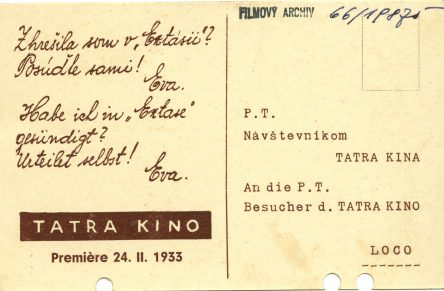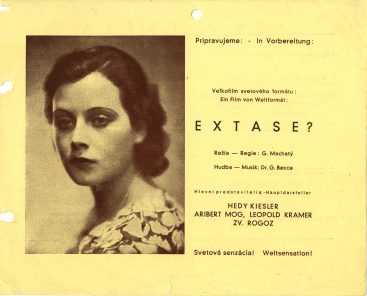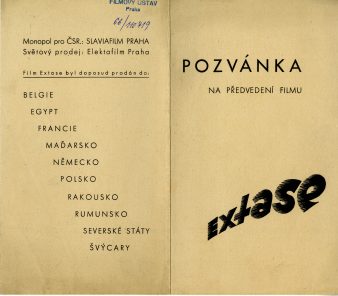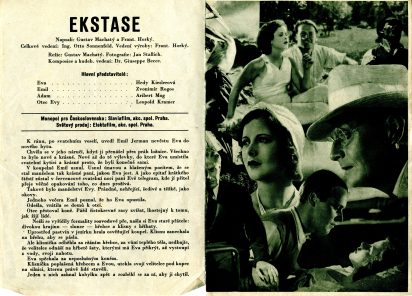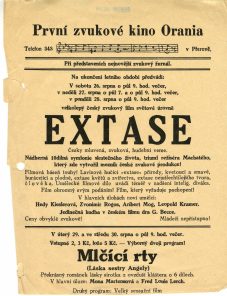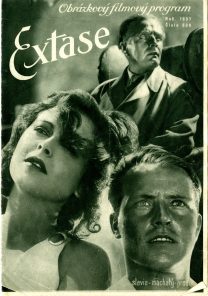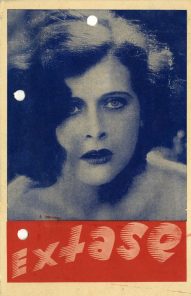Gustav Machatý´s ambition to shoot an internationally recognized film started with a conscientious screenwriting preparation. In 1931 he first approached Otto Rádl and offered him to work together on the script, then the writer Emil Vachko and then Vítězslav Nezval, with whom he already wrote the melodrama From Saturday to Sunday (Ze soboty na neděli, 1931). The final wording of the libretto, however, is a mutual work of Machatý and František Horký, who was also the head of production.[1] A say to the script also had Otto Sonnenfeld, the director of the Slaviafilm company, a subsidiary of Elektafilm, which provided necessary funds to shoot Ecstasy. The fame Machatý earned by his previous work secured him a lucrative contract. He became a co-producer of the film entitled to the ownership of the negative without having to invest his own money. His contribution was yet to be paid from his profit share. Thus, for Machatý, the makeweight of provided artistic freedom, so rare in Czechoslovakia, was the fear (as a producer) whether the film will pay. This made a commercial success, ideally not only in Czechoslovakia, something very desirable.
Machatý “pre-paid” the interest of foreign distributors by a wonderful idea with a promise of open view of a woman´s body and sexuality, an international cast (actors from Austria, France, Yugoslavia…), by engaging an Italian music composer, or his decision to produce three language versions right from the start. First screen tests with Hedy Kieslerová, Aribert Mog, Zvonimir Rogoz and Mirek Eliáš took place at the beginning of July 1932 in A-B studios, which were the only ones that were equipped with a sound recording system. In the same month, a contract with the director of photography Jan Stallich was signed, necessary permissions to make the film in Slovak exteriors were obtained (among others at the State Stud Farm in Topoľčianky, in Subcarpathian Rus or on the Červená Skala – Margecany railway) and the music author Giuseppe Becce was contacted so that he could start composing ahead of schedule.
The crew put up in the Dobšiná village on 23 July.[2] From there they would set out to make the film in other parts of Slovakia. Simultaneously with the shooting, negotiations to choose the casts for individual language versions were proceeding. For instance, a French company Gaumont conditioned their financial contribution by assigning the role of Adam to Pierre Nay. The father of the main heroine was to be portrayed by André Nox. Although Machatý preferred identical cast to keep the different versions´ colour united, in the end he submitted to the French co-producer´s request, despite his reservations about the lack of Nay´s acting skills, and he cast both French actors in the French version to increase its attractiveness for their particular audience. While Sonnenfeld, acting on behalf of Elektafilm, was responsible for sales of the film to individual European countries from Prague, Machatý, Stallich and four cameramen (one silent, one sound, two hand) were in Slovakia patiently waiting for a suitable weather and ideal light conditions, progressing more slowly than planned.
In half of August, Hedy Kieslerová, whom Machatý discovered in Berlin, arrived from Vienna in Topoľčianky (she would later become famous as Hedy Lamarr).[3] During the filming, the only eighteen-year-old actress at that time was excited about her role. Much less her parents though. Her father intended to let her go only under the condition that her mother would accompany her. But Hedy didn´t want to be embarrassed by her parental escort. She considered herself mature enough to manage the filming on her own and in the end she got her way to go to Czechoslovakia without her mother´s supervision. The role of frustrated Eve, who escapes from unsatisfying marriage and finds satisfaction in her lover´s arms, became for her both a blessing and a curse due to/thanks to her nakedness, even though mainly implied or assumed. The Ecstasy´s reputation as an erotic film was, above all, a proof of Gustav Machatý´s and his co-workers´ marketing skills who were able to sell, even at that time, a quite mild melodrama, which was unanimously approved by the censoring board, as an exciting spectacle which breaks a number of taboos.
At the end of August 1392, prior to the filmmakers return to Prague, Machatý received a telegram from Slaviafilm expressing a great delight from the first shots. However, the management was less happy about prolonging the filming time and a growing budget. The total sum was supposed to be 745 thousand Czech crowns but this amount was spent even before finishing the exterior shooting in Slovakia. The final cost was about 2 million. Also the goal to finish the studio shooting by 5 March, when the contract with Stallich was to expire, seemed unrealistic (only about three quarters were actually finished by that time). Sonnenfeld, who was however suspecting that an extraordinary work of art is being created from the daily shots he saw, adopted towards Machatý´s conscientious and technical approach to each shot unusually lenient approach. When it became clear that the time dedicated for shooting in A-B studios in Vinohrady won´t suffice, Sonnenfeld arranged for shooting in Schönbrunn studios in Vienna. Hastily secured permission from the Department for International Trade and the National Bank was supposed to be paid for in foreign currency earned from selling Ecstasy abroad.
On 18 January 1933, after the shooting was finished, the film was cut and the music was recorded, the world premiere of the film, accompanied by the Radio-Journal station orchestra in Prague Lucerna, could take place. The prelude was conducted by Giuseppe Becce himself. In Lucerna and Kotva, two premiere Prague cinemas, Ecstasy topped for six weeks. Before long it premiered in Slovak, France or Austria. There, the film set up a great commotion, also thanks to the ballyhoo and casting a countrywoman in the lead role. The Austrian premiere took place in four cinemas simultaneously and in first two weeks, over seventy thousand tickets were sold.[4] The successful foreign campaign of Ecstasy concluded on 7 August by premiering on the second year of the Venice Film Festival. After that the film´s popularity increased even more and in the following months it was also sold to Palestine, Brazil or Japan. Since its creation, Ecstasy was sold to more than fifty countries. By the end of 1934, the earnings from selling the film abroad were coming closer to the production costs, i.e. to about two million crowns. However, the materials specifying how much Sonnenfeld had invested in the large-scale marketing campaign, apart from the advertisements in newspapers and magazines, including also a vast number of posters and photos of partially revealed Kieslerová, weren´t preserved.
The Ecstasy versions screened in individual states, however, didn´t differ only in their language and cast. In Germany, for example, the film (having a painfully sweet name Symphonie der Liebe) started screening only two years after the Prague premiere and in considerably censored version, which changed the colour of a number of scenes and the film as a whole. In the US, the screening of the film was completely banned on the initiative of the Moral League. Ecstasy got to American cinemas with an added happy end only in 1937. To British cinemas, it was let in even one year after that. Different renditions of existing copies, crippled by censoring bodies and individual cinema owners alike, who were tempted in adding a souvenir in the form of a few negative slides with naked Kieslerová to their private collection, made subsequent efforts to restore the film to its former rendition much more difficult since the original Czech negative wasn´t preserved.
Period reviews in Czechoslovak press focused mainly on the international dimension of the film and Machatý´s attempt to shoot a new type of sound film, which paradoxically rather “rehabilitates the silent film” as stated in the Lidové noviny newspaper, instead of fully utilizing the possibilities of sound technology. Most critics, however, were positive about the use of mainly film means of expressing at the expense of dialogs (or, alternatively, the use of nature or human bodies as vehicles of meaning) because they thought there was too much talking in other sound films of that time. When the film was beginning to screen, there were already speculations whether Machatý didn´t decide to restrict the use of the spoken word in order to make selling the film to other countries easier. Although the tone of reviews was mainly positive, or sometimes even excited, and the critics agreed that Ecstasy is a world-class film which “significantly stands above the today´s poor level of regular production” (Večerník Národních listů), we also repeatedly come across certain reservations towards the film.
Many perceived Machatý´s approach as too technical and cold, lacking real excitement as promised by the film´s name. He reportedly puts the photographic aspect above the seriousness and logic of the story and supports not very dramatic plot by music and exaggerated use of optical tricks. It is said that he focused too much on creating impressing pictures and atmosphere while neglecting the psychological explanation of the characters´ actions. “Surrealism and Russian patterns of scenes and cuts definitely didn´t do much good to Ecstasy because, first of all, the film was supposed to win with its inner truthfulness”, wrote Q. E. Kujal for Český filmový zpravodaj, and to support his extensive analysis he also used some European classics when stating that “Machatý tends to forget that he is no Ibsen, Tolstoy or Strindberg, who were handling sexual dramas beyond comparison.” Not once, there was an opinion that Machatý, in his endeavour to create a cosmopolitan film, created something unoriginal, “a mere conglomerate of all imaginable components put right next to each other “(Telegraf).
Already quoted Kujal was also one of the critics that Ecstasy made to think about women’s emancipation in an interesting way: “Everyone, who has seen the film, could as well ask themselves a question: is it ecstasy – or just an ovulation, that every woman today is prepared for in almost any time and not just in some specific periods, as it used to be in the old days?” The rhetorical question captures the film´s ambivalence in its approach to women´s sexuality that, even though, is sometimes free of all patriarchal requirements, sometimes it submits to the men´s point of view and demands of the society. After a woman, compared to a healthy mare in one scene, experiences a physical pleasure beyond the limits of the marital institution, she is inevitably tamed. The tribute for an unbound pleasure is accepting the “traditional” role of a mother who contributes to the development of the society.
With the years passed and having a more comprehensive idea of Czechoslovak film production of that time we can note that Ecstasy constitutes a defiance of a simple plot, is a representative, formally elaborated and thought-out work of an author who wasn´t compelled to agree to a compromise and had enough time for its preparation and realization.
Martin Šrajer
Ecstasy (Extase, Czechoslovakia, 1932), director: Gustav Machatý, screenplay: Gustav Machatý, František Horký, director of photography: Jan Stallich, music: Giuseppe Becce, editor: Antonín Zelenka, cast: Hedy Kiesler, Aribert Mog, Zvonimir Rogoz, Leopold Kramer, Karel Mácha-Kuča, Jiřina Steimarová, Jan Sviták et al. Elekta, Gustav Machatý, 90 min.
Notes:
[1] The cameraman Jan Stallich declares Horký in his memoirs as the father of the film.
[2] According to Jan Stallich´s memoirs, the crew stayed in a cosy hotel in a forest and enjoyed delicious meals prepared by the director´s mother.
[3] The role of Eve was originally meant to be portrayed by a Mexican actress Lupita Tovar but she declined when she found out that she would have to appear naked in the film.
[4] The screening of Ecstasy in Vienna was allegedly accompanied by unrest because the cinema operators were promising more than the film actually showed. The director of the Atlantis-Film company and the director of the cinema where Ecstasy premiered were then brought before the court because they hang out Kieslerová´s naked photos in order to promote the film, which could have had a detrimental effect on the “sexual feelings of the youth”. It is reported that violent demonstrations later took place also in Madrid, where the period press wrote that the audience “demolished a cinema and requested their money back”.
